Cockroach Pest Control Singapore (The Cockroach Killer)
How to get rid of cockroaches through our range of Singapore cockroach control services?
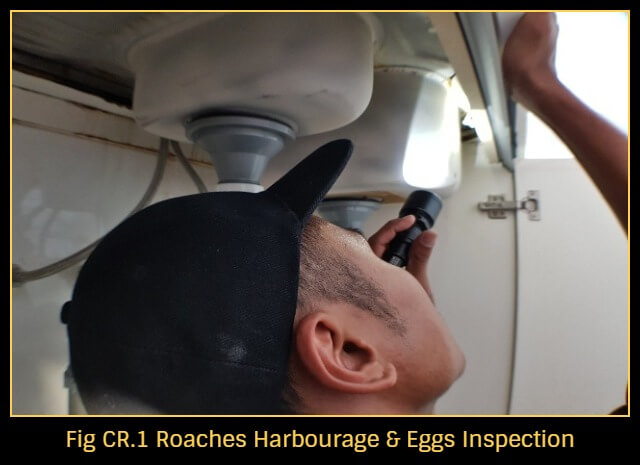
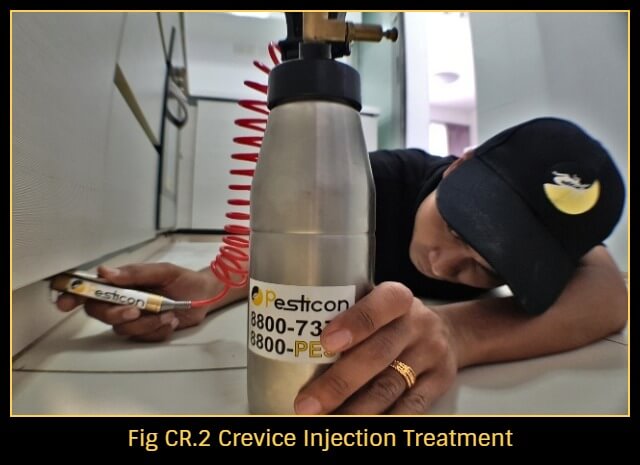
Pesticon’s cockroach treatment and cockroach control Singapore: Inspection will be carried out at the premises, to isolate areas that are prone to or having an existing cockroach infestation. Once isolated, we will attempt to locate the cockroach eggs and nesting areas. Baiting at strategic nesting locations will then be carried out, using professional grade, high potency and long-lasting cockroach bait (cockroach gel and granules). Residual spraying will also be conducted at cockroach prone areas, providing longer-term control for foraging cockroaches. Regardless of big or small cockroaches in kitchen, cockroach powder may also be dusted at entry points, to enhance the longevity of cockroach control. The active ingredients in the products we use, generally target the nervous system of the cockroaches. This is one of the best way to kill cockroaches. Cockroach killer gel when consumed by one cockroach, can lead to the death of other cockroaches. This secondary killing effect happens, when other cockroaches feed on the carcasses and faeces of those, that had fed on our best roach bait, like cockroach gel bait. For heavy infestations, indoor pest control cockroach treatment via misting, may be needed to plummet the existing population, before commencing maintenance program. After the initial roach infestation treatment, cockroach traps may be deployed to monitor the progress.

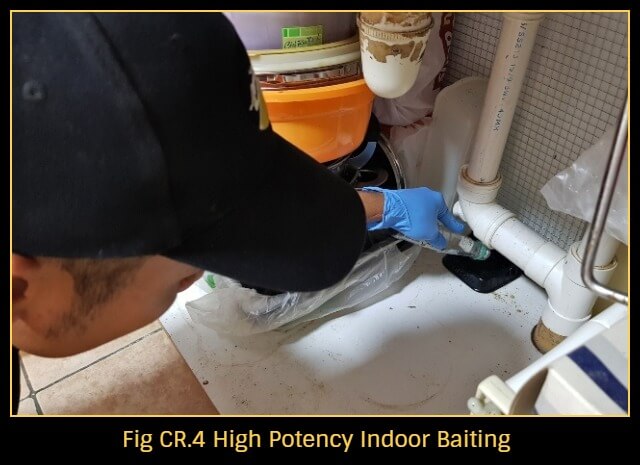
Pest control services Singapore (Exterminate annoying cockroaches in house)
Our pest control services for cockroach management, do not stop short at getting rid of cockroach. During our cockroach pest control services, any baby cockroach or cockroach egg case discovered, will be destroyed to terminate the life cycle of cockroach.
Here at Pesticon, we don’t just think how to kill cockroaches, we think how to get rid of cockroaches fast. We adopt the most effective cockroach control methods, combining integrated pest management and cockroach pesticide. We constantly seek out the most effective cockroach killer, be it the best cockroach bait or the best pesticide for cockroaches. Therefore, we like to think of ourselves, as a strong contender among the best pest control companies in Singapore.
Pest control Singapore cockroach
Cockroaches are among the most common pests and belong to the order Blattodea. There are more than 4600 species of cockroaches in the world. But only 30 species dwell among humans. Out of these 30 species, only a few are regarded as common household pests. These cockroach species include, but are not limited to German Cockroach, American Cockroach, Brown Banded Cockroach, Australian Cockroach and Oriental Cockroach.
Cockroaches are highly adaptable and can live in a wide range of environments and climates. They thrive in tropical and subtropical regions, showing a preference for warm and humid areas, especially in buildings and sheltered areas. Many studies have shown, German Cockroaches are growing increasingly resistant, to a wide range of pesticides. They have even evolved, to avoid roach baits containing sugar. Pesticon’s home cockroach treatment, utilises bait rotation, to counter the possible effects of pesticide resistance.
Health risks: Cockroaches are culprits in spreading many diseases. For eg. salmonellosis, plague, gastroenteritis, typhoid fever, dysentery, cholera, asthma (cockroach antigen) and many more.
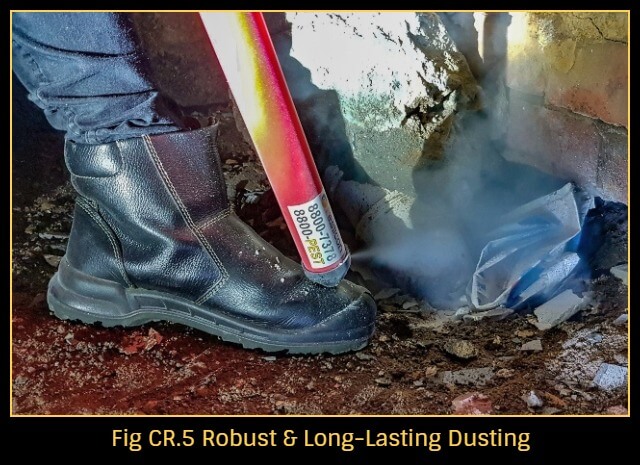
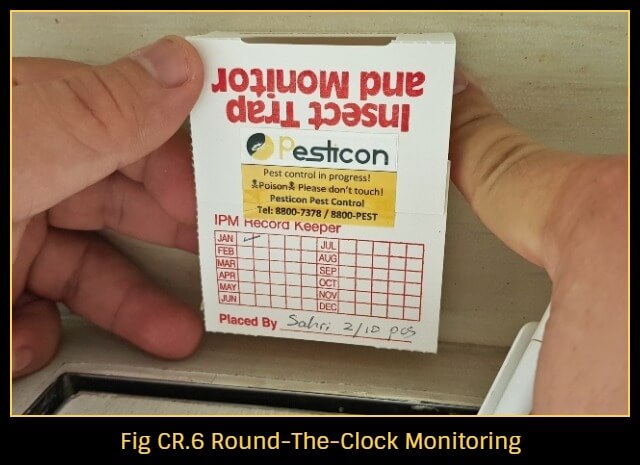
3 common types of cockroaches in Singapore
German Cockroach Singapore
The German Cockroach is a highly successful and invasive species of cockroach. Its scientific name is Blattella Germanica. These cockroaches have wings but seldom fly. They prefer to glide for short distances when disturbed. The German Cockroach and the Asian Cockroach looks almost identical, and a common person would not be able to differentiate between the two. One of the main differences between them is, the Asian Cockroach can fly like a moth, while the German Cockroach prefers not to. German Cockroaches are not very large in size. They are usually around 11 mm to 16 mm long. The colouration of these cockroaches varies from tan to black. Two dark prominent streaks, run lengthwise down of its pronotum. The pronotum is a plate-like structure, which segregates the head and the wings. German Cockroaches show a strong preference for indoor habitats, taking full advantage of the food and shelter we unintentionally provide. They thrive in houses, buildings, hospitals, nursing homes, food processing plants, restaurants, etc. We have even found them in places, that we regularly assume as hygienic. Namely offices, medical facilities and nurseries. In the temperate zone, they limit their harbourage areas to human habitats. This is because they are highly sensitive to cold and are unlikely to survive the cold outdoors. German Cockroaches have long been regarded, as the inquiline and domiciliary pest of human habitats. If you wish to know how to get rid of German Cockroaches, call Pesticon for our German Cockroach treatment, and let our cockroach exterminator pay you a visit.
Although the German Cockroach is a nocturnal pest, it will from time to time appear during the day. This is especially true when the infestation is heavy, and their harbourages are overcrowded. You can commonly find them during the night when the lights are dimmed. Any attempt to swat these foragers might turn up to be a foul-smelling event. They are known to emit an unpleasant odour when they are frightened or excited. German Cockroaches are omnivorous scavengers and their diet include sugar, meat, greasy food and other starchy stuff. However, if their favourite food scraps are not available, they can make do with household items like soaps, toothpaste, glue and book bindings. When food shortage occurs, they turn cannibalistic. They will consume each other’s body parts, particularly the legs and wings. Studies of their microbial load, indicate that German Cockroaches, function as both a reservoir and also as a potential vector for some bacterial pathogens.
The German Cockroach life cycle ranks top, among all other species of domiciliary cockroaches. The German Cockroach eggs, carried by the female cockroach, will develop into baby german cockroach, within a month in Singapore’s tropical climate. From eggs to adults, it takes approximately two months. The female cockroach can lay an approximate 4 – 8 egg cases in a lifetime. Each German Cockroach egg case (ootheca), can produce around 18 – 50 baby German Cockroaches (nymph). If you find that you are fighting a losing battle, against German Cockroaches, give us a call. We provide effective and affordable pest control in Singapore.
American Cockroach Singapore
The American Cockroach is perhaps, the most notorious of all flying cockroaches. They go by the scientific name of Periplaneta Americana. The American Cockroach despite its name, is not native to the United States of America. They were originally from Africa, and likely to have entered North America, via commercialised sea freights. This could also be the reason, as to why they have an alternative name, as the Ship Cockroach.
Among the common species of cockroaches, the American Cockroach is the largest. Before metamorphosis, they moult for a total of 6 – 14 times. Their length usually hovers within the 30 mm to 50 mm range. American Cockroaches are reddish brown in colour, and their pronotum is flanked by a pale yellowish-brown border. The pronotum is referred by some, as “the shoulder” of the cockroach. The baby American Cockroach looks almost identical to the adult, except that it’s the shrunken and wingless version of one.
American Cockroaches have impressive lifespans. Males live approximately 12 months and the females can live up to 20 months. As with all cockroaches, the life stages of the American Cockroach, progresses from the initial stage as an egg, the growing stage as a nymph and finally the reproductive stage as an adult. Interestingly, female American Cockroaches can reproduce, without the help of the males, through the process of parthenogenesis.
American Cockroaches are super adaptive and opportunistic feeders. One of the reasons why they are such successful pest, has got to be their all-inclusive diet. They eat practically everything. Apart from the regular foodstuffs, they feed on dead skin flakes, book bindings, wall paper paste, leather and other cockroaches (vomitus and droppings included). Interestingly, as with some humans, fermented food are their favourites. If you are having an American Cockroach infestation, call Pesticon for cockroach control at home. We will carry out the best way to get rid of cockroaches.
Brown Banded Cockroach Singapore
The Brown Banded Cockroach is one of the most overlooked species, responsible for cockroach infestation in offices and homes. Its scientific name is Supella Longipalpa. They are approximately 1 – 2 mm smaller than the German Cockroach. The Brown Banded Cockroach has colouration, very similar to that of the German Cockroach. One of the main distinguishing features, is the two pale coloured bands, that go across the abdomen and wings of the Brown Banded Cockroach. These bands may appear intermittent and in the case of females, the wings do not cover their abdomen completely.
The Brown-Banded Cockroach has different selection criteria when it comes to harbourages. It is less dependent on moisture, as compared to both the American and the German Cockroach. Therefore, Brown-Banded Cockroaches can easily be found, in areas not known to be high in moisture level. They are most commonly found in electrical appliances, furniture, storerooms and wardrobes. Conversely, the American and the German Cockroaches, are usually found near gully traps, bin chutes, refrigerators and restaurants. Aside from the above, Brown Banded Cockroaches are also occasionally found, in delivery crates and carton boxes. If you have a new infestation of these critters, after accepting recent delivery, this maybe it. Give us a call and let our home pest control service assists you.
15 fun facts about cockroaches
-
Termites are wood-feeding cockroaches
Do you know that cockroaches are biologically classified in the order of Blattodea? An order which includes termites. It is a fact that termites are now considered, to be unique cockroaches that feed on wood. -
The prehistoric insect
Cockroaches are incredible survivors, extremely adaptable and have been living on earth much longer than humans. They are known to have evolved 359 million years ago, since the Carboniferous period. -
Double trouble
Most of the common cockroaches that we have seen, do not exceed 2 inches. An official record states that the longest cockroach in the world, comes from a Central and South American species, known as the Megaloblatta Longipennis. It measures 3.8 inches long and has a wingspan of 8 inches. That’s around double the size of the common American Cockroach. -
Cold blooded
Being poikilothermic (cold-blooded), their low metabolic rate, allows them to survive about 30 days without food. -
Low maintenance diet
Being omnivorous scavengers, they eat practically all organic matters. Their super-efficient digestive systems, let them draw nutrients from items like leather, book bindings, fingernails and hairs. -
The headless survivor
These guys can live without their heads for a week or more. They can also hold their breath for 40 minutes and remain underwater for 30 minutes. -
Fast runners
You may have seen cockroaches running frantically around your residence. Right from their birth, they are fast runners. They can run at a human’s equivalent of 330km/h. -
They are alcoholic
Ever heard of alcoholic cockroaches? The American Cockroach loves beer, and it’s likely that the hops and sugar got them fixated, instead of the promises of a foam party. -
Seriously, a jumping cockroach?
There is a species of cockroach in South Africa (Table Mountain), which can jump 50 body lengths in a single bound, and is affectionately known as the Leaproach. -
Cockroach milkshake?
Cockroaches produce a form of nutrient dense milk crystals, that contains 3 to 4 times the energy as compared to regular dairy milk. While it’s still not in mass production, many are already considering it, as the next superfood. -
Disgusting pests or useful bugs?
For the uninitiated, cockroaches might just be unhygienic, disease carrying and disgusting vectors. But in China, they are useful insects and part of a huge scale farming revolution. They are professionally bred for the food, pharmaceutical & composting industries. -
They fart
Cockroaches fart and they do so once every 15 minutes. They can produce up to 35 grams of methane, in a single year of farting. That’s 43 times their own body weight. -
They recognise their family
Some species of cockroaches have the ability to recognise their own family. It’s called kin recognition. Such an ability likely served as a deterrence to inbreeding. -
They can feel lonely
Cockroaches are social insects with gregarious behaviour. While they are not as sophisticated as other eusocial insects or humans, they can certainly feel lonely and behave abnormally when forced into isolation. -
Cockroach trainees
Yes, cockroaches have been trained and conditioned to salivate, in response to a stimulus. Conditioning is only possible when memory & learning exist. Hence, it’s not wrong to say that, cockroaches have memories and can learn.